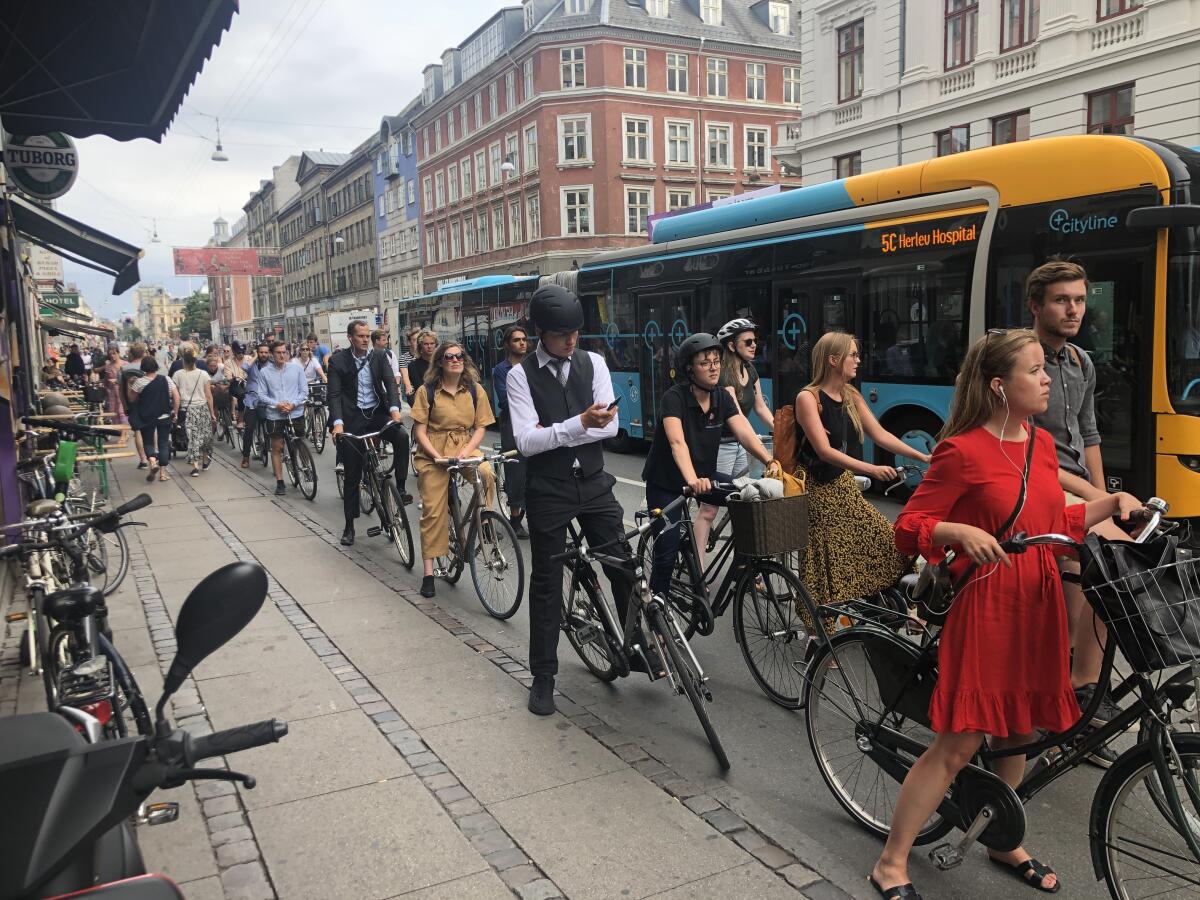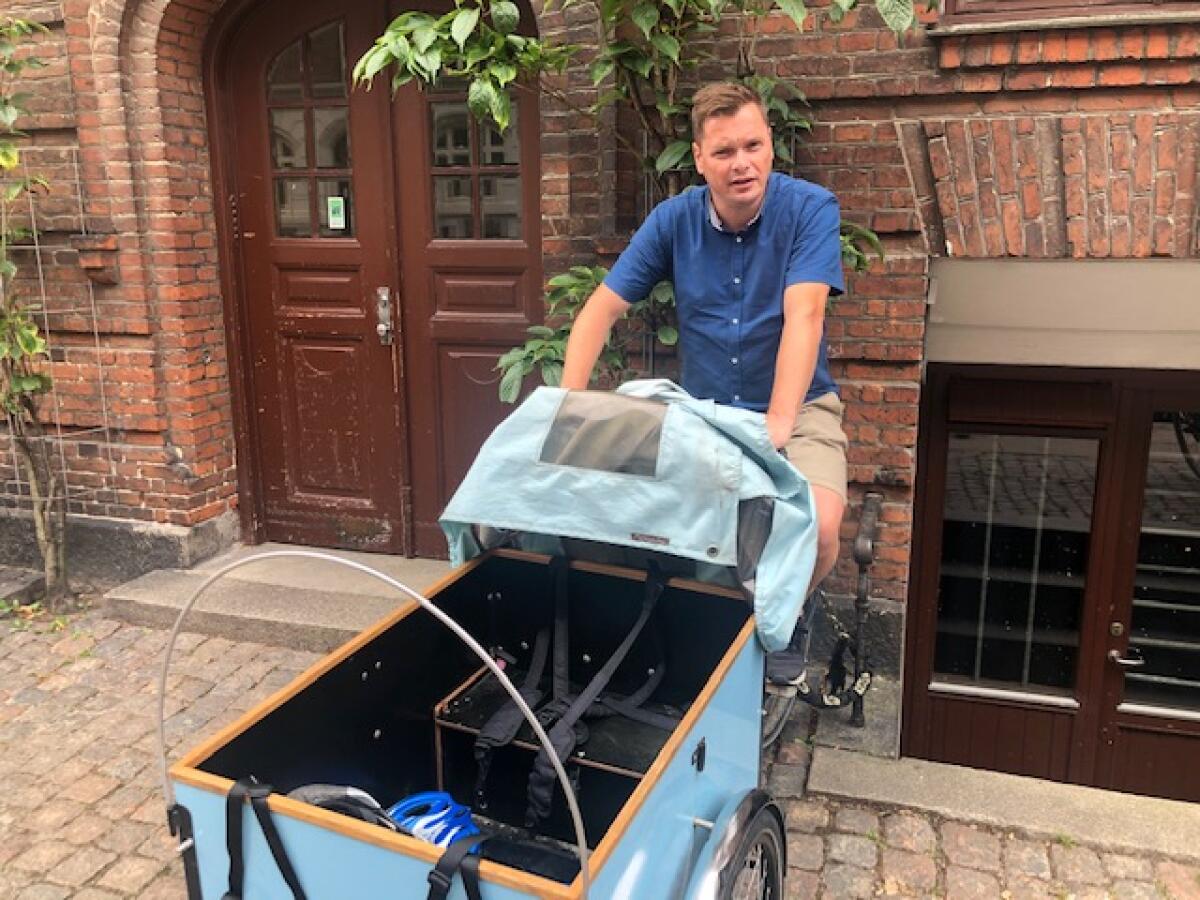Copenhagen has taken bicycle commuting to a whole new level

As part of Copenhagen’s attention-grabbing pledge to become the world’s first carbon-neutral capital city by 2025, it has aimed to improve the already impressive biking infrastructure.
Soren Jensen sold his car six years ago and joined the rivers of rolling humanity who bicycle through Copenhagen every day. He quickly lost about 50 pounds on his hour-a-day bike commutes, while saving time and a small fortune.
“I had a Mercedes but it sat in the garage all the time because it was so much easier to get everywhere by bike,” said Jensen, a 51-year-old who works in a downtown investment bank. He got rid of the car, which was costing him about $500 a month, after moving from the suburbs to the city and finding that he didn’t need it anymore.
“I don’t miss it at all,” the 6-foot-7 Jensen added before setting off on the ride home on a warm summer evening. He said he’d been looking forward to it all afternoon. “The hour on the bike is time I don’t have to spend in a gym. I got healthier and look forward every day to all that fresh air. Life’s good.”

Cycling has been a part of the good life in Copenhagen for decades. It started its modern comeback in 1973 after global oil price shocks hit motorists in this once-grimy industrial city hard. Despite windy and rainy conditions for much of the year, biking in Copenhagen became increasingly popular in the 1980s and 1990s, thanks to a build-it-and-they-will-come mentality — and plenty of public clamoring for a network of wide, segregated cycling lanes elevated a few inches above street level.
In recent years, cycling has enjoyed yet another surge in popularity — the result of constantly improving bike lanes coupled with fears of climate change. Global warming presents an existential threat to this Baltic Sea port, which lies just a few feet above sea level.
Copenhagen’s city government reported in early July that 62% of its residents are now commuting to work or school by bike — an increase from 52% in 2015 and 36% in 2012, when the City Council launched a 14-year-plan to improve the quality, safety and comfort of cycling. Those bikers pedal an estimated total of 800,000 miles a day. According to local reports, there are more bikes (675,000) than people in Copenhagen, and five times as many bicycles as cars.
As part of Copenhagen’s attention-grabbing pledge to become the world’s first carbon-neutral capital city by 2025, there has been a spate of activity in recent years to improve the already impressive biking infrastructure. The aims are to lure more riders, lower carbon emissions and help the Danish capital stay ahead of Amsterdam and other cities.

“We’re a biking city, and we want to be the best in the world,” Klaus Mygind, a member of Copenhagen’s City Council in charge of transport policy, said in an interview. “We have a lot of work to do still. I’m not a car hater. But I think we need to do all we can to stop most car travel into the city. We need more bikes, fewer cars.”
Mygind, 63, a member of the ruling far-left Socialist People’s Party, believes many more Danes are switching to cycling because they feel a responsibility to future generations.
“I do think the climate change problem is what has been motivating even more to take the bike,” he said. “They think that if they’re riding their bike instead of in a car, they’re helping to fight the problem in a small and personal way.”
All walks of life can be seen pedaling against the wind during the morning and evening rush hours. With lanes wide enough for two and sometimes even three bikes, riders are for the most part cordial and careful with nary a road hog in the peloton. It’s not unusual to see lawyers, doctors and business professionals in suits or dresses standing on their bikes at red lights next to butchers, bakers and clerks.
“I think biking is good for the society — it keeps people together,” Mygind said.
The advent of electric bikes, which has helped a growing number of senior citizens join the cycling craze, and the more recent arrival this year of electric scooters, which have attracted hipsters to the bike paths, have also been contributing factors to the recent boom in two-wheeled travel.

“You see a lot more electric bikes out there these days,” said Lars Mathiasen, a 46-year-old podcaster and video journalist who hasn’t owned a car since 2002. He gets around with his three children sitting in the front of his box-like cargo bike. “You see more people who would probably struggle to ride a regular bike due to a bad knee or bad back or because they’re overweight are now out there riding electric bikes.”
To make commuting by bike even easier, faster and more comfortable, Copenhagen has built 17 new bridges dedicated for bicycles over the city’s harbors and canals since 2006 — 15 of them in the last four years. Also, a series of more than a dozen supercykelsti — or cycle superhighways — have been set up to create higher-speed, traffic-light-free bike paths from the suburbs that stretch up to 15 miles.
Taken together, the efforts to bolster the cycling infrastructure while making driving and parking into the city prohibitively expensive and difficult send strong signals to commuters about where the priorities lie. (A parking ticket can cost as much as $80.)
“Cycling has truly exploded in the last 10 years,” said Yael Bassan, a 29-year-old entrepreneur whose Copenhagen Bicycles shop rents out about 2,000 bikes per day — nearly triple the number of four years ago. “It has even become an important tourist attraction in its own right. People come to Copenhagen from around the world to do some serious cycling in the city, or they just want to ride around for a few hours to get a few pictures to be able to prove they were cycling in Copenhagen.”

Bassan, who bikes about 12 miles a day herself, said children grow up with bikes from a very early age — a bit like Canadians who learn to skate from the time they can walk.
“I’ve never had a car,” she said. “It doesn’t make any sense in Copenhagen.”
There are more than 250 miles of bike lanes in Copenhagen, according to the Danish Foreign Ministry, and some 600 miles of bike paths in the greater Copenhagen area. (By contrast, Los Angeles, a vastly bigger and more populous city, has about 145 miles of freestanding bike paths or separated bike lanes.) Nine out of 10 Danes own a bike.
“I go everywhere by bike and don’t think I’ve driven a car in at least 15 years,” said Sune Scheibye, 43, who works at Copenhagen’s modern new Amager Bakke waste incinerator, which doubles as a power plant and features a 450-yard-long ski slope down its roof. “It’s like getting dressed or brushing your teeth in the morning. You get on your bike every day because it’s there. So no one really ever asks themselves if it’s better to bike or drive a car. Biking is what we do.”
Kirschbaum is a special correspondent.
More to Read
Sign up for Essential California
The most important California stories and recommendations in your inbox every morning.
You may occasionally receive promotional content from the Los Angeles Times.










